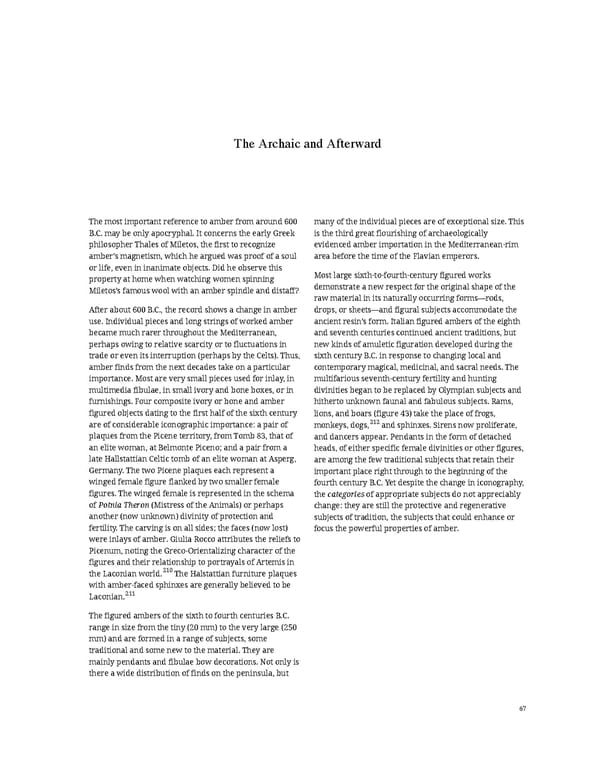The Archaic and Afterward The most important reference to amber from around 600 many of the individual pieces are of exceptional size. This B.C. may be only apocryphal. It concerns the early Greek is the third great flourishing of archaeologically philosopher Thales of Miletos, the first to recognize evidenced amber importation in the Mediterranean-rim amber’s magnetism, which he argued was proof of a soul area before the time of the Flavian emperors. or life, even in inanimate objects. Did he observe this property at home when watching women spinning Most large sixth-to-fourth-century figured works Miletos’s famous wool with an amber spindle and distaff? demonstrate a new respect for the original shape of the raw material in its naturally occurring forms—rods, After about 600 B.C., the record shows a change in amber drops, or sheets—and figural subjects accommodate the use. Individual pieces and long strings of worked amber ancient resin’s form. Italian figured ambers of the eighth became much rarer throughout the Mediterranean, and seventh centuries continued ancient traditions, but perhaps owing to relative scarcity or to fluctuations in new kinds of amuletic figuration developed during the trade or even its interruption (perhaps by the Celts). Thus, sixth century B.C. in response to changing local and amber finds from the next decades take on a particular contemporary magical, medicinal, and sacral needs. The importance. Most are very small pieces used for inlay, in multifarious seventh-century fertility and hunting multimedia fibulae, in small ivory and bone boxes, or in divinities began to be replaced by Olympian subjects and furnishings. Four composite ivory or bone and amber hitherto unknown faunal and fabulous subjects. Rams, figured objects dating to the first half of the sixth century lions, and boars (figure 43) take the place of frogs, are of considerable iconographic importance: a pair of monkeys, dogs,212 and sphinxes. Sirens now proliferate, plaques from the Picene territory, from Tomb 83, that of and dancers appear. Pendants in the form of detached an elite woman, at Belmonte Piceno; and a pair from a heads, of either specific female divinities or other figures, late Hallstattian Celtic tomb of an elite woman at Asperg, are among the few traditional subjects that retain their Germany. The two Picene plaques each represent a important place right through to the beginning of the winged female figure flanked by two smaller female fourth century B.C. Yet despite the change in iconography, figures. The winged female is represented in the schema the categories of appropriate subjects do not appreciably of Potnia Theron (Mistress of the Animals) or perhaps change: they are still the protective and regenerative another (now unknown) divinity of protection and subjects of tradition, the subjects that could enhance or fertility. The carving is on all sides; the faces (now lost) focus the powerful properties of amber. were inlays of amber. Giulia Rocco attributes the reliefs to Picenum, noting the Greco-Orientalizing character of the figures and their relationship to portrayals of Artemis in the Laconian world.210 The Halstattian furniture plaques with amber-faced sphinxes are generally believed to be Laconian.211 The figured ambers of the sixth to fourth centuries B.C. range in size from the tiny (20 mm) to the very large (250 mm) and are formed in a range of subjects, some traditional and some new to the material. They are mainly pendants and fibulae bow decorations. Not only is there a wide distribution of finds on the peninsula, but 67
 Ancient Carved Ambers in the J. Paul Getty Museum Page 76 Page 78
Ancient Carved Ambers in the J. Paul Getty Museum Page 76 Page 78
